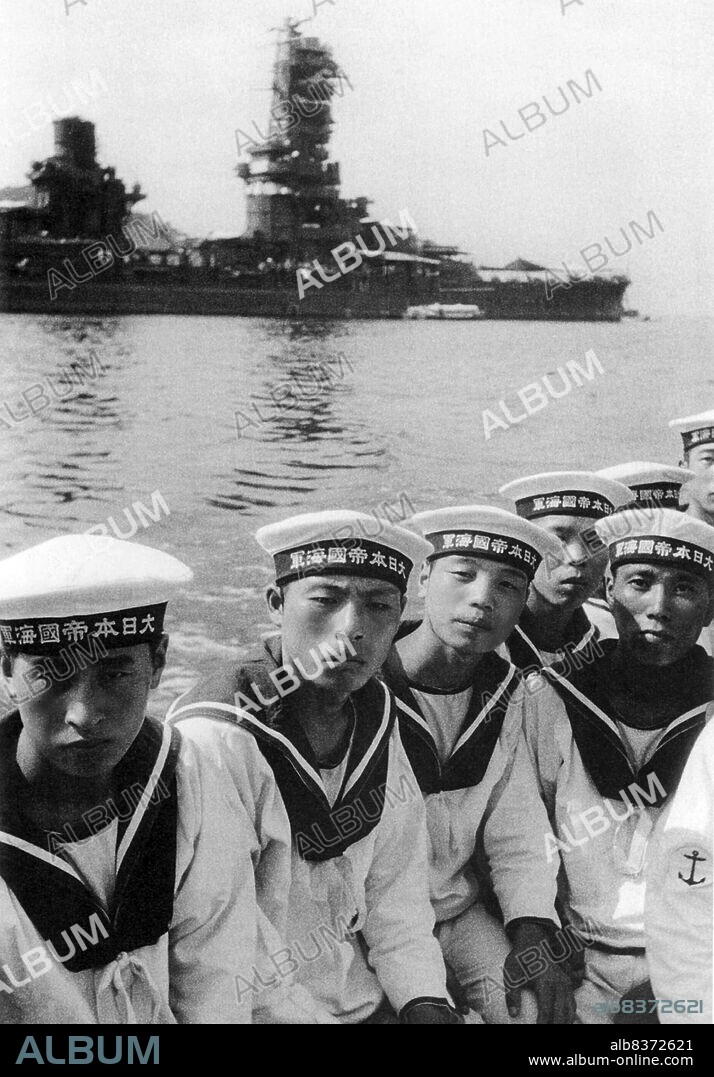alb8372621
Japan: Crew members of the Japanese battleship Fuso moored in the background, Kure, Hiroshima, May 1943

|
Ajouter à une autre Lightbox |
|
Ajouter à une autre Lightbox |



Avez-vous déjà un compte? S'identifier
Vous n'avez pas de compte ? S'inscrire
Acheter cette image.
Sélectionnez l'usage:

Titre:
Japan: Crew members of the Japanese battleship Fuso moored in the background, Kure, Hiroshima, May 1943
Légende:
Voir la traduction automatique
Fuso (a classical name for Japan) was the lead ship of the two Fuso-class dreadnought battleships built for the Imperial Japanese Navy. Launched in 1914 and commissioned in 1915, she initially patrolled off the coast of China, playing no part in World War I. In 1923, she assisted survivors of the Great Kanto Earthquake.
. Fuso was modernized in 193035 and again in 193741, with improvements to her armor and machinery and a rebuilt superstructure in the pagoda mast style. With only 14-inch guns, she was outclassed by other Japanese battleships at the beginning of World War II, and played auxiliary roles for most of the war.
. Fuso was part of Vice-Admiral Shoji Nishimura's Southern Force at the Battle of Leyte Gulf. She was sunk in the early hours of 25 October 1944 by torpedoes and naval gunfire during the Battle of Surigao Strait. Some reports claim that Fuso broke in half, and that both halves remained afloat and burning for an hour, but according to survivors' accounts, the ship sank after 40 minutes of flooding. Of the few dozen crewmen who escaped, only 10 survived to return to Japan.
. Fuso was modernized in 193035 and again in 193741, with improvements to her armor and machinery and a rebuilt superstructure in the pagoda mast style. With only 14-inch guns, she was outclassed by other Japanese battleships at the beginning of World War II, and played auxiliary roles for most of the war.
. Fuso was part of Vice-Admiral Shoji Nishimura's Southern Force at the Battle of Leyte Gulf. She was sunk in the early hours of 25 October 1944 by torpedoes and naval gunfire during the Battle of Surigao Strait. Some reports claim that Fuso broke in half, and that both halves remained afloat and burning for an hour, but according to survivors' accounts, the ship sank after 40 minutes of flooding. Of the few dozen crewmen who escaped, only 10 survived to return to Japan.
Crédit:
Album / Universal Images Group / Pictures From History
Autorisations:
Taille de l'image:
3489 x 5005 px | 50.0 MB
Taille d'impression:
29.5 x 42.4 cm | 11.6 x 16.7 in (300 dpi)
Mots clés:
1939-1945 • ARMEE: SOLDATS • ASIE • ASIE, CONTINENT • BATEAU DE GUERRE • CONTINENT ASIE • DEUXIEME GUERRE MONDIALE • GUERRE MONDIALE II • GUERRE NAVIRES • GUERRE • GUERRE, NAVIRES • JAPON • JAPONAIS • JAPONAISE • MARIN • MARINE MARINS • MARINIER • MARINS • MATELOT • MILITAIRE • NAVAL • NAVALE • ORNEMENT, JAPONAIS • SECONDE GUERRE MONDIALE • SOLDAT DE L'ARMEE POPULAIRE NATIONALE • SOLDAT • VIE MILITAIRE ET ARMEMENT


 Pinterest
Pinterest Twitter
Twitter Facebook
Facebook Copier le lien
Copier le lien Email
Email
